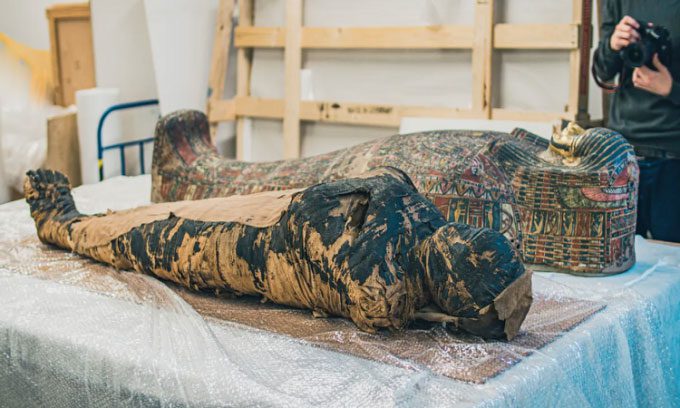The “Mysterious Lady” Mummy Shows Signs Similar to Modern Nasopharyngeal Cancer Patients.
Scientists are investigating the cause of death of the “Mysterious Lady”, a 2,000-year-old Egyptian mummy that remarkably preserves a stillborn fetus. Upon examining the mummy’s skull, they suspect that the woman likely died from cancer.

Pregnant woman’s mummy next to the coffin. (Photo: Warsaw Mummy Project)
In the 19th and 20th centuries, this mummy was believed to belong to a priest. However, the Warsaw Mummy Project reveals that the deceased is a woman. Notably, this is also the first case of a pregnant mummy. Earlier this year, CT scans of the “Mysterious Lady” provided further evidence that the pelvic cavity of the remains contains a fetus. This fetus was preserved due to the high acidity and low oxygen concentration of the mummy’s womb, resulting in an extremely well-preserved state.
The researchers involved in the project continue to investigate how the young woman died. Other images of the mummy’s skull reveal unusual markings in the bones, indicating that the woman had cancer. The markings on the skull resemble signs that modern doctors often see in patients with nasopharyngeal cancer, a rare type of cancer that affects the throat area located between the back of the nose and the back of the mouth.
“In the CT scan, there is a small pathological change with a diameter of about 7 mm, which is a round lesion around a hollow cavity in the bone behind the left eye socket. This is likely a change due to a tumor, possibly a metastatic area,” said Wojciech Ejsmond, director of the Gebelein archaeological project and co-director of the Warsaw Mummy Project.
Ejsmond explained that such changes in the skull bones occur after a glandular tumor, and examining the histology will provide clear answers. Additionally, there are holes in the facial bones, including the nasal cavity, maxillary sinus, and palatine bone. The changes in the facial skull bones are similar to symptoms of nasopharyngeal cancer in patients today.
To confirm the cancer diagnosis, the research team needs to examine the mummy’s tissues. Identifying cancer in real tissues allows expert doctors to detect “molecular traces” of cancer found in the mummy and then compare it with contemporary cancer cases, thereby understanding the evolutionary process of cancer.
Researchers have previously found many ancient mummies showing signs of cancer in their bodies. In 2017, scientists discovered the oldest known case of breast cancer and multiple myeloma in two mummies dating back to 2000 and 1800 BC, in the Qubbet el-Hawa cemetery in Aswan. It is likely that these mummies belonged to the ruling elite of ancient Egypt.




















































